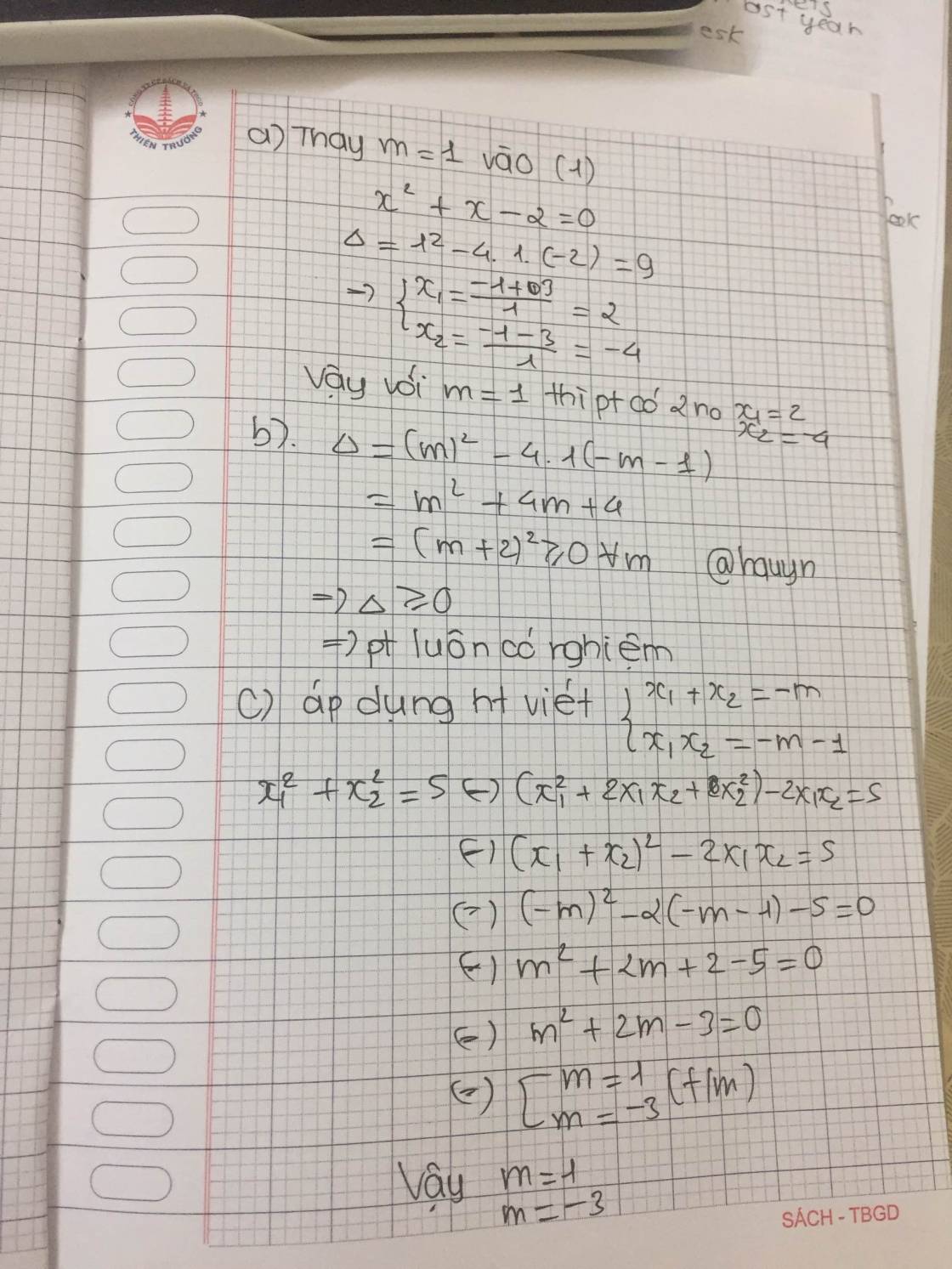
Hãy nhập câu hỏi của bạn vào đây, nếu là tài khoản VIP, bạn sẽ được ưu tiên trả lời.


a: khi m=1 thì pt sẽ là:
x^2+3x+1=0
=>\(x=\dfrac{-3\pm\sqrt{5}}{2}\)
b: Δ=(2m+1)^2-4m^2
=4m+1
Để phương trình có nghiệm kép thì 4m+1=0
=>m=-1/4
Khi m=-1/4 thì pt sẽ là:
x^2+x*(-1/4*2+1)+(-1/4)^2=0
=>x^2+1/2x+1/16=0
=>(x+1/4)^2=0
=>x+1/4=0
=>x=-1/4

a: Khi m=-1 thì phương trình sẽ là:
x^2-(-3-1)x+2-1-1=0
=>x^2+4x=0
=>x=0 hoặc x=-4

a: Khi m=-2 thì phương trình trở thành \(x^2+2x-3=0\)
=>(x+3)(x-1)=0
=>x=-3 hoặc x=1
b: \(\text{Δ}=\left(-2\right)^2-4\left(m-1\right)=4-4m+4=-4m+8\)
Để phương trình có hai nghiệm phân biệt thì -4m+8>0
=>-4m>-8
hay m<2
Theo hệ thức Vi-et, ta có:
\(\left\{{}\begin{matrix}x_1+x_2=-2\\x_1x_2=m-1\end{matrix}\right.\)
Theo đề, ta có:
\(\left\{{}\begin{matrix}x_1+x_2=-2\\x_1-2x_2=0\end{matrix}\right.\Leftrightarrow\left\{{}\begin{matrix}x_2=-\dfrac{2}{3}\\x_1=2x_2=-\dfrac{4}{3}\end{matrix}\right.\)
Ta có: \(x_1x_2=m-1\)
\(\Leftrightarrow m-1=\dfrac{8}{9}\)
hay m=17/9(nhận)
a. Thay m=-2 ta được: \(x^2+2x-2-1=0\Leftrightarrow\left[{}\begin{matrix}x=1\\x=-3\end{matrix}\right.\)
b. Để phương trình (*) có 2 nghiệm phân biệt thì \(\Delta=4-4\left(m-1\right)>0\Leftrightarrow1>m-1\Leftrightarrow m< 2\)
Áp dụng định lí Vi-et ta có: \(x_1+x_2=\dfrac{-2}{1}=-2\)
Ta có: \(\left\{{}\begin{matrix}x_1+x_2=-2\\x_1-2x_2=0\end{matrix}\right.\) \(\Rightarrow\left\{{}\begin{matrix}x_1=-\dfrac{4}{3}\\x_2=\dfrac{-2}{3}\end{matrix}\right.\)\(\Rightarrow x_1.x_2=\dfrac{m-1}{1}=\dfrac{-4}{3}.\dfrac{-2}{3}=m-1\Rightarrow m=\dfrac{17}{9}\)<2
Vậy m=\(\dfrac{17}{9}\)

a: Khi m=2 thì (1) trở thành \(x^2+2x-3=0\)
=>(x+3)(x-1)=0
=>x=-3 hoặc x=1
b: \(\text{Δ}=2^2-4\cdot\left(m-5\right)=4-4m+20=-4m+24\)
Để phương trình có hai nghiệm thì -4m+24>=0
=>-4m>=-24
hay m<=6
Theo đề, ta có: \(x_1x_2\left(x_1+x_2\right)=8\)
\(\Leftrightarrow-2\left(m-5\right)=8\)
=>m-5=-4
hay m=1(nhận)

a.
Khi \(m=2\) pt trở thành:
\(2x+3=0\Rightarrow x=-\dfrac{3}{2}\)
b.
Để pt có nghiệm \(x=-1\)
\(\Rightarrow\left(m^2-m\right).\left(-1\right)+m^2-1=0\)
\(\Leftrightarrow-m^2+m+m^2-1=0\)
\(\Leftrightarrow m-1=0\)
\(\Leftrightarrow m=1\)
c.
Pt tương đương:
\(\left(m^2-m\right)x=-\left(m^2-1\right)\)
\(\Leftrightarrow m\left(m-1\right)x=-\left(m-1\right)\left(m+1\right)\)
Pt vô nghiệm khi:
\(\left\{{}\begin{matrix}m\left(m-1\right)=0\\-\left(m-1\right)\left(m+1\right)\ne0\end{matrix}\right.\) \(\Leftrightarrow m=0\)
\(\Rightarrow\) pt có nghiệm khi \(m\ne0\)
Pt có vô số nghiệm khi:
\(\left\{{}\begin{matrix}m\left(m-1\right)=0\\-\left(m-1\right)\left(m+1\right)=0\end{matrix}\right.\) \(\Leftrightarrow m=1\)
Lời giải:
a. Khi $m=2$ thì pt trở thành:
$2x+3=0\Leftrightarrow x=-\frac{3}{2}$
b. Để pt có nghiệm $x=-1$ thì:
$(m^2-m).(-1)+m^2-1=0$
$\Leftrightarrow m-1=0\Leftrightarrow m=1$
c.
PT $\Leftrightarrow (m^2-m)x=1-m^2$
Để pt vô nghiệm thì: \(\left\{\begin{matrix} m^2-m=0\\ 1-m^2\neq 0\end{matrix}\right.\Leftrightarrow \left\{\begin{matrix} m(m-1)=0\\ (1-m)(1+m)\neq 0\end{matrix}\right.\)
\(\Leftrightarrow m=0\)
PT có vô số nghiệm khi \(\left\{\begin{matrix} m^2-m=0\\ 1-m^2= 0\end{matrix}\right.\Leftrightarrow m=1\)
Để PT có nghiệm thì: $m\neq 0$

a.Bạn thế vào nhé
b.\(\Delta=3^2-4m=9-4m\)
Để pt vô nghiệm thì \(\Delta< 0\)
\(\Leftrightarrow9-4m< 0\Leftrightarrow m>\dfrac{9}{4}\)
c.Ta có: \(x_1=-1\)
\(\Rightarrow x_2=-\dfrac{c}{a}=-m\)
d.Theo hệ thức Vi-ét, ta có:
\(\left\{{}\begin{matrix}x_1+x_2=-3\\x_1.x_2=m\end{matrix}\right.\)
1/ \(x_1^2+x_2^2=34\)
\(\Leftrightarrow\left(x_1+x_2\right)^2-2x_1x_2=34\)
\(\Leftrightarrow\left(-3\right)^2-2m=34\)
\(\Leftrightarrow m=-12,5\)
..... ( Các bài kia tương tự bạn nhé )

a Khi m=1 thì (1) sẽ là x^2+1=0
=>x thuộc rỗng
b: Thay x=1 vào (1),ta được:
1^2-2(m-1)+m^2=0
=>m^2+1-2m+2=0
=>m^2-2m+3=0
=>PTVN
c: Thay x=-3 vào pt, ta được:
(-3)^2-2*(m-1)*(-3)+m^2=0
=>m^2+9+6(m-1)=0
=>m^2+6m+3=0
=>\(m=-3\pm\sqrt{6}\)

\(a,m=1\Rightarrow x^2+x-1=0\\ \Leftrightarrow\left\{{}\begin{matrix}x=\dfrac{-1+\sqrt{5}}{2}\\x=\dfrac{-1-\sqrt{5}}{2}\end{matrix}\right.\\ b,\Delta=\left(2m-1\right)^2+4m=\left(2m\right)^2-4m+1+4m\\ =4m^2+1>0\forall m\)
--> Phương trình luôn có 2 nghiệm phân biệt
--> Không có giá trị m để pt vô nghiệm
a, Thay m = 1 vào pt trên ta được
\(x^2+x-1=0\)
\(\Delta=1-4\left(-1\right)=1+5>0\)
Vậy pt luôn có 2 nghiệm pb
\(x_1=\dfrac{-1-\sqrt{6}}{2};x_2=\dfrac{-1+\sqrt{6}}{2}\)
b, Ta có : \(\Delta=\left(2m-1\right)^2-4\left(-m\right)=4m^2+1< 0\)( vô lí )
Do \(4m^2\ge0\forall m\Rightarrow4m^2+1>0\forall m\)
hay ko có gtri nào của m để pt vô nghiệm


a. Khi m = 1:
\(\left(x+1\right)^2=0\Leftrightarrow x+1=0\Leftrightarrow x=-1\)
\(a,m=1\Leftrightarrow x^2+2x+1=0\Leftrightarrow x=-1\\ b,\Leftrightarrow\Delta=4-4m< 0\Leftrightarrow m>1\)